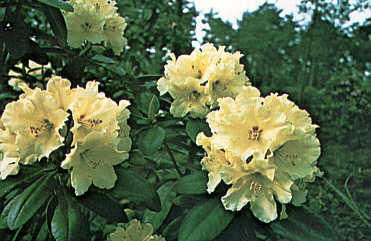QBARS - v26n3 The Breeding of Hardy Rhododendrons
The Breeding of Hardy Rhododendrons
Friedrich W. Dürre
Article translated from German by Dr. Herbert Heckenbleikner,
Quarterly Bulletin Contributing Editor.
The American Rhododendron Society has asked us for the results of our breeding efforts for hardiness. A rather difficult affair because the possibilities used were so numerous and a comprehensive report would fill many volumes. In order to shorten this communication I will point out the means Dietrich Hobbie in Linswege (Oldb.), West Germany, used to achieve the desired results.
The starting point for the entire breeding work was to utilize the well known garden hybrids of Europe with significant inheritance from R. catawbiense . Interesting wild species were sent, among others, by the then Director of the Royal Botanic Garden of Edinburgh, Sir William W. Smith from the collection there. From 1938 on he also sent seeds from the expeditions of Sherriff, Kingdon-Ward and Professor Hu. In 1939 seeds of the Tibet Expedition of Dr. SchMer were obtained. Equally valuable were arrivals from Japan and the U.S. It was especially Mr. Gable who sent valuable material from 1937 on. One thinks, in this matter, especially of R. catawbiense album var. Glas, which is a pure white form with exceptional hardiness that does not contribute the unwanted purple color. Mr. Gable also sent seedlings of his own breeding with which one could easily work further. The northwestern section of Germany is well suited and known for the growing of rhododendrons because of the good climatic conditions and the humus sandy loam which can easily be enriched from the neighboring elevated peat bogs. However, at least every fifth winter a lengthy hard freeze as low as -20°C will destroy the more tender rhododendrons. It is important thus that every breeding speculation, employ a hardy partner. The previously named catawbiense album var. Glass - short, 'Catalgla' - is such a partner which reliably fulfills its duty as a hardener. Especially good results were shown in the crossing with souliei , puralbum , griersonianum , astrocalyx , wardii , 'Jock,' 'Hebe,' viscidifolium (a tender species, blooming a wonderful honey yellow, Sherriff Exp. 1939) and others. It is interesting that it was even possible to harden the quite tender griersonianum . The pollen was sent from the Edinburgh Botanical Garden. The deep rose, beautiful, freely flowering hybrids survived every winter in the Botanical Garden of Munich without damage (according to reports from the well known dendrologist Fritz Heiler, deceased). In the Netherlands several clones of this cross are being propagated by cooperating nurserymen.
|
||||
|---|---|---|---|---|
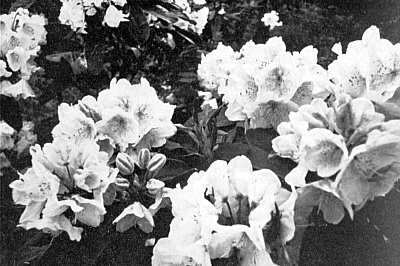 |
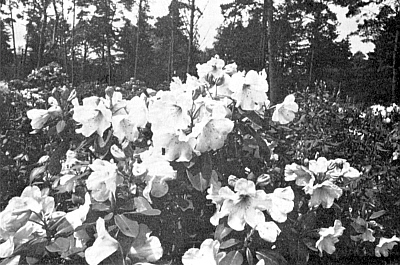 |
|||
FIG. 50. R. brachycarpum var. montanum x souliei |
FIG. 54. 'Catalgla' x R. souliei Photo courtesy Dietrich Hobbie |
|||
One must, naturally, in the hardening process, be just as careful that the other partner is fine and also large flowered. This is especially true of the hybridization with brachycarpum and it forms: brachycarpum montanum and brachycarpum tigerstedtii (a very hardy rose form from Korea). Hybrids of this wild species with various red garden hybrids were not handsome enough. A too intensive marking caused the flowers, from the distance, to appear unclean and not bright. Naturally the plants themselves were able to stand the below zero temperatures of Karlstad, Sweden. Better and just as hardy results were obtained with crosses of 'Inamorata' and souliei. Species of the Thomsonii Series or at least varieties with thomsonii inheritance are partners of the first rank with brachycarpum. Similar observations hold also for yakushimanum.
Many breeders complain that the hybrids attain the beauty of the parent forms in only a few cases. At Linswege we have had best results with crosses of thomsonii breeding. An especial champion here: yakushimanum x wardii 5679 from the Sherriff expedition. The best clones will most certainly find their way into gardens.
As is known, during the last ten years we have held back on registering names in order not to enlarge the confusing duplication on the list of new hybrids. We have all seen that the majority of these "novelties" could not stand hard reality. And we are of the opinion that all rhododendron breeders should use still stricter standards in selecting parent plants and the naming of clones otherwise "The International Rhododendron Register" will become an impenetrable jungle of pretty names but only a few good plants.
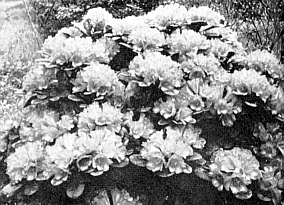 |
|---|
FIG. 53. 'Soumi' (forrestii var. repens hybrid x metternianum) |
As a further good partner for achieving better hardiness, metternianum has proven itself here in Linswege. R. metternianum is probably a natural hybrid between metternichii and degronianum. In selfing (pure offspring) this form has five and also seven-petaled corollas. Especially good results are: forrestii var. repens hybrids x metternianum = 'Soumi' and ('Dainty' x 'Doncaster') x metternianum. In the latter cross it is interesting that haematodes with its double calyx still distinctly holds over in 'May Day' and 'Dainty' in the cross with R. metternianum, even though it is represented by only 6.25% in the total inheritance. Good results were also obtained with crosses of metterianum with viscidifolium and with discolor hybrids.
R. chrysanthum in its various forms has also been worthwhile. For this purpose a quite flat growing form, with deep canary yellow flowers from the north Japanese island of Hokkaido was used and also a somewhat higher growing form neiko montanum and finally a still larger type blooming whitish-yellow from Lake Baikal. These were especially successful crossed with campylocarpum (deep yellow flowers), with 'Cowslip' (yellowish rose) and with 'Mrs. Lindsay Smith' x williamsianum (cream white). All these hybrids grow compactly, hemispherical and are extraordinarily hardy. Beautiful rose red and orange rose flowered creeping hybrids resulted from crosses with forrestii var. repens and repens hybrids. Most suited for snowy and cold winter areas they are, however, early blooming and therefore not suited for late frost sites.
It is interesting that many seedlings of crosses with chrysanthum from Hokkaido developed double flowers. This condition is also anchored in the ancestry thereof. Dietrich Hobbie received this specimen seed given him by Mr. E. J. P. Magor, while visiting him in Cornwall in 1937. Mr. Magor had just received the seed from Mr. Wada of Japan. One of the seedlings is today, after 35 years, a mound 70 cm. wide and 25 cm. high, a jewel of our collection!
In the breeding of the quite early blooming, hardy species such as metternianum, chrysanthum and especially forrestii var. repens one must be careful to choose a partner with the opposite characteristic, namely late blooming variety. The best cross with repens is with "Essex Scarlet.' Even though the English grown partner chosen is not hardy here it gave better results crossed with repens. With other hardy partners all the offspring, in general, suffered from late frosts in May which always destroyed the flowers and also the new growth. Naturally there were also other weaknesses such as the burning of the blooms on opening due to heat and strong light. For example, in the cross of 'Dr. V. H. Rutgers' x repens of approximately 5,000 seedlings, there were only two good ones and of these two only one remains for propagation purposes. Of a total of about 20,000 seedlings of repens hybrids there are still 12 clones left. Among these the well known one called 'Scarlet Wonder'. A further good partner which holds its beauty nicely in Linswege is oreodoxa var. haentatocheilum. In crossing it with well known somewhat tender red garden hybrids, even with the variety 'Britannia,' there always results good, hardy offspring. Also smirnowii has resulted in good hardiness inheritance.
An especially brilliant gem among our species, in its inheritance as well as in its exterior, is vernicosum aff. This type was collected in Likiang, Yunnan by Prof. Hu on his expedition in 1939 under seed number 14935. Wide, good growing, full of luxuriant leaves which never suffer damage here; and in addition large, pure light rose trusses with noble, silky corollas, of indescribable patina. All of these characteristics of vernicosum 14935 are passed on to the most varied partners.
The inheritance of a cross of M. Koster & Sons, Boskoop in the year 1910 is interesting, namely 'Mrs. Lindsay Smith'
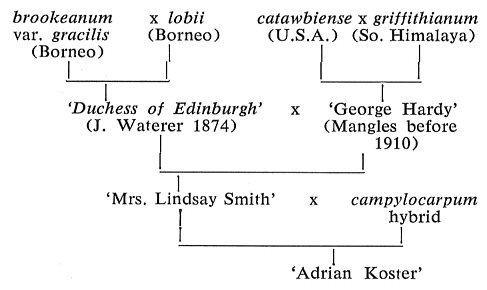 |
|---|
The inheritance of 'Mrs. Lindsay Smith' itself as well as its offspring 'Adrian Koster' crossed with various partners, especially with williamsianum proved to be excellent here in Linswege, even though both varieties are not quite hardy in our climate. This is only clarified when one takes into account the part played in the inheritance by the presence of catawbiense. Also a small percentage of the inheritance of such a "hardiness maker" can work wonders in later generations. The best clone: 'Mrs. Lindsay Smith' x williamsianum = 'Gustav Luttge' (delicate rose-white) and 'Adrian Koster' x williamsianum = 'Gartendirektor Walter Rieger' (champagne-colored). Of over 60 different combinations of williamsianum hybrids with several thousand seedlings there are now only 11 clones being propagated, which are, according to our view of real value for enriching our gardens and parks. Among them a probable polyploid cross of 'Dr. V. H. Rutgers' x williamsianum. We have named it after a German rhododendron pioneer "August Lamken". The dark rose large flowers are especially hardy.
Besides the above named three varieties, the following williamsianum hybrids have revealed themselves as outstanding, all of which are now in the trade: 'Gartendirektor Glocker' (cherry red, bronze colored new growth), 'Jackwill' (pale rose, end of April), 'Lissabon' (carmine red, rounded growth). 'Oldenburg' (pale rose, large campanulate), 'Oudyks Sensation' (rich red blooms), 'Psyche' (large flowered, rose, beautiful habit), 'Rodhatte' (blood red, loose truss, and lime tolerant because it has R. didymum as an ancestor) and 'Vater Bohlje' (catawbiense compactum x williamsianum, very winter hardy, rounded, luxuriant growth with pale lilac rose flowers). These are the results of many years of selection.
Among the lepidote rhododendrons we have had good results with carolinianum (received from Mr. Gable over 25 years ago). In crossing with ciliatum we obtained several hundred seedlings, which have since become 2-3 meters high and wide. All of these are uniformly hardy with snow-white trusses. We are still selecting from the best mother plant. Similar very handsome hybrids were obtained from crossing with lutescens. Here also the carolinianum inheritance produced outstanding hardiness. From lutescens was inherited reddish colored foliage and light yellow flowers mostly overcast with peach colors. A quite valuable enrichment.
A R. lapponicum form discovered by Dietrich Hobbie, near Great Slave Lake is also interesting. This form grows there to a height of 50-70 centimeters in a heavy peat substrate about 50 cm. thick, mixed with various Vacciniums. In contrast to the prostrate growing types this form is amenable to cultivation. Because of its taller growth it possesses a tough vitality against the northern winter, whereas the flat lapponicum is usually sheltered under the snow. Dr. Bruckner of St. Johns, New Brunswick, Canada, has been working with the Great Slave Lake form, for many years, with considerable success.
Outstanding is certainly a white dauricum form which we received from Dr. Rokujo of Japan. In extreme hardiness the developing hybrid seedlings show pure colors. A trusty plant in its inheritance is russatum. The variety 'Lavendula' produced in 1952 carries as its inheritance partner saluenense and rubiginosum. 'Lavendula' is large flowered, lavender rose, of compact growth, fragrant, with bronze foliage in winter, freely blooming and hardy. A further outstanding plant of our own breeding we find in the dark blue, noble 'Blue Wonder,' a russatum x augustinii hybrid.
Crosses with R. keleticum have also been quite promising and in the coming year a first class clone of clear pink bloom buds and excellent vitality can be named.
Of the Japanese azaleas we found nakaharai to be of special interest in breeding for winter hardiness. The specimen used by us (sent by Dr. Rokujo) bloomed dark red in June and crawled over the ground in a prostrate fashion. It is itself not only a delightful enrichment for the border and rock garden but is good for breeding material. Using it one can certainly delay the time of bloom of many of the well known hybrids.
In conclusion it is clear from the preceding observations that the English breeders, because of their favorable climatic situation in comparison to us, certainly have the advantage. However, we still have unused possibilities for breeding hardy rhododendrons in still colder climates of the world, which will produce varieties of beauty to equal those of milder climates.
Finally, I would like to repeat the words of the deceased Dutch breeder Hugo Koster as spoken to my father in-law, Dietrich Hobbie: "Time will tell".

